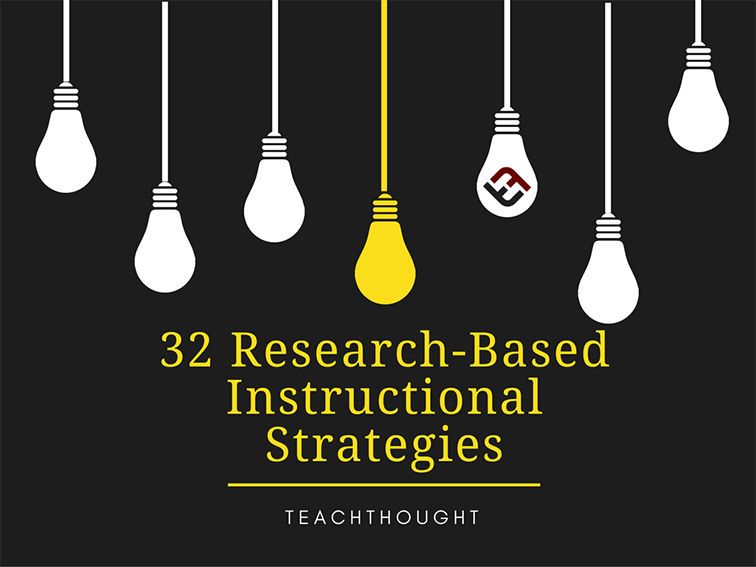32个基于研究的教学策略

32基于研究的教师教学策略
经过教师员工
您想教授已被证明工作的内容。那讲得通。
在the ‘data era’ of education that’s mean research-based instructional strategies to drive data-based teaching, and while there’s a lot to consider here we’d love to explore more deeply, for now we’re just going to take a look at the instructional strategies themselves.
帖子不是最好的方法,诚实地分享这种信息。每个人的视频可能更好,所以也许是一个YouTube频道?或一本书,哈蒂和玛拉诺等人已经完成了。专业发展也可能 - 采取12项策略,也可以与教师合作,将它们融入不同类型的课程可能是有用的。(看Hattie的效果尺寸指数。)
But upside to sharing this information as a post is that it can act a starting point to research the above, which is why we’ve tried to include links, related content, and suggested reading for many of the strategies, and are trying to add citations for全部他们参考了展示战略的有效性的原始研究。(这是一个正在进行的过程。)
你应该如何使用这样的列表?在6个问题哈蒂没有问,Terry Heick想知道相同。
“代替任何问题,这么大的数据必须有用。正确的?也许。但是,可能需要如此多的努力来定位和重新校准它一个特定的背景,这是它只是没有 - 特别是当它让学校和地区成为“研究人员”的“研究人员”,而不是在Hattie的名单上倾斜。Imagine ‘PDs’ where this book has been tossed down in the middle of every table in the library and teachers are told to ‘come up with lessons’ that use those strategies that appear in the ‘top 10.’ Then, on walk-throughs for the next month, teachers are constantly asked about ‘reciprocal teaching’ (.74 ES after all). If you consider the analogy of a restaurant, Hattie’s book is like a big book of cooking practices that have been shown to be effective within certain contexts: Use of Microwave (.11 ES) Chefs Academic Training (.23 ES), Use of Fresh Ingredients (.98). The problem is, without the macro-picture of instructional design, they are simply contextual-less, singular items.”
简而言之,这些教学策略已经证明,在至少一项研究中,“有效”。如上所述,这并不是那么简单 - 它并不意味着它在你的下一课中会很好地工作。但是作为一个开始仔细看看似乎工作的地方 - 更重要的是,它如何以及为什么它的作用 - 可以自由开始使用下面的列表。vwin.com德赢
32基于研究的教师教学策略
1.确定目标
2.加强努力/提供认可
3.合作学习
4.提示,问题和提前组织者
5.非创造性的陈述(见用类比教学)
6.概述和注意拍摄
7.识别相似之处和差异
8.生成和测试假设
9.使用九类战略的教学计划
10.根据特定绩效标准(Wiersma 1992)奖励
11.稍后级别的家庭作业(罗斯1998年),父母参与最小(Balli 1998),目的明确(1985年)
12.直接教学
13。脚手架教学
14.为学生练习提供机会
15.个性化教学
16.基于查询的教学(见20个问题要指导基于探究的学习)
17.概念映射
18.互惠教学
19.促进学生元认知(见5o促进学生元拍的问题)
20.为每个学生制定高期望
21.提供明确有效的学习反馈(见有效学习反馈的具体例子)
22.教师清晰度(学习目标,期望,内容交付,评估结果等)
23.设定目标或目标(Lipset&Wilson 1993)
24.一致,“低威胁”评估(Bangert-Drowns,Kulik,&Kulik 1991; Fuchs&Fuchs 1986)
25.更高级别的质疑(Redfield&Rousseau 1981)(见问题源于更高级别的讨论)
26.学习详细和特定的反馈(Hattie&Hydergly 2007)
27。指示的阅读思维活动(Stauffer 1969)
28.质疑答复关系(QAR)(Raphael 1982)
29. kwl图表(ogle 1986)
30.比较矩阵(Marzano 2001)
31.预期指南(Buehl 2001)
32.响应笔记本(Readence,Moore,Rickelman,2002)
来源:玛拉诺研究;可见学习;http://www.sde.ct.gov/sde/lib/sde/pdf/curriculum/section7.pdf.;32个基于研究的教学策略
